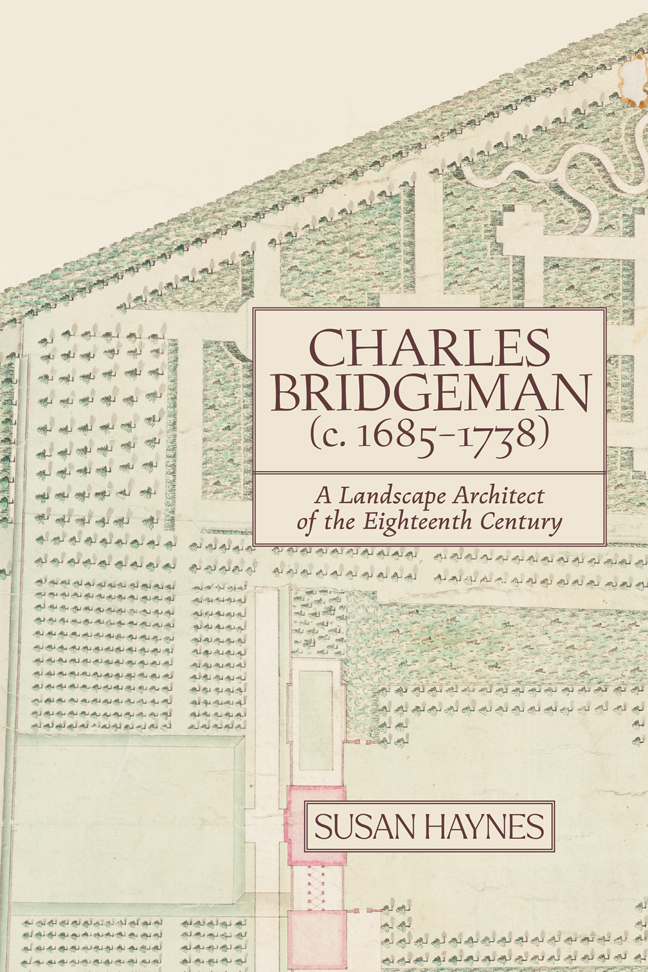Book contents
- Frontmatter
- Dedication
- Maps
- Contents
- List of Illustrations
- Acknowledgements
- List of Abbreviations
- Introduction
- Chapter 1 Who Was Charles Bridgeman?
- Chapter 2 Towards A Reliable Corpus
- Chapter 3 A Revised Catalogue
- Chapter 4 Reading The Plans
- Chapter 5 The Art-Historical Context Revisited
- Chapter 6 The ‘Ingenious Mr Bridgeman’
- Chapter 7 Building a Landscape
- Chapter 8 A Commercial Enterprise
- Conclusion
- Appendix I A summary of Willis's catalogue from Charles Bridgeman and the English Landscape Garden
- Appendix II A revised catalogue
- Appendix III Bridgeman's projects by year
- Appendix IV Bridgeman's income
- Gazetteer of Bridgeman sites
- Glossary
- Bibliography
- Index
- Miscellaneous Endmatter
- Frontmatter
- Dedication
- Maps
- Contents
- List of Illustrations
- Acknowledgements
- List of Abbreviations
- Introduction
- Chapter 1 Who Was Charles Bridgeman?
- Chapter 2 Towards A Reliable Corpus
- Chapter 3 A Revised Catalogue
- Chapter 4 Reading The Plans
- Chapter 5 The Art-Historical Context Revisited
- Chapter 6 The ‘Ingenious Mr Bridgeman’
- Chapter 7 Building a Landscape
- Chapter 8 A Commercial Enterprise
- Conclusion
- Appendix I A summary of Willis's catalogue from Charles Bridgeman and the English Landscape Garden
- Appendix II A revised catalogue
- Appendix III Bridgeman's projects by year
- Appendix IV Bridgeman's income
- Gazetteer of Bridgeman sites
- Glossary
- Bibliography
- Index
- Miscellaneous Endmatter
Summary
CHARLES BRIDGEMAN DESERVES greater fame than posterity has granted him. This book has been an attempt to set right that injustice, to remove him from obscurity and place him in the canon of famous gardeners and garden designers of the past and present. The names of Bridgeman's near contemporaries, André Le Nôtre, William Kent, Lancelot Brown and Humphrey Repton, are common currency even amongst those whose knowledge of gardening and landscape history is sketchy, as are the names of Gertrude Jekyll and Vita Sackville West in the modern era. Bridgeman's name should be equally well known.
As we have seen, he was far more famous, popular and highly regarded in his period than his modern reputation suggests: a man of competence, taste and intellect, esteemed by his peers and in great demand amongst his clientele. His popularity may have been because he was a consummate practitioner, probably a better practitioner than several on the list above whose names are better known. In an age when a successful garden designer needed to be competent in a number of disparate disciplines, he was the master of them all. His surveying was accurate and rigorous. He was conversant with techniques of building, planting and hydraulics. He was a skilled draughtsman, producing accurate scale plans, but also an artist, capable of beautiful watercolour versions of his designs, and bird’s-eye views in which the landscape was visualised in a threedimensional form.
He may also have been something of an entrepreneur, and perhaps this was another reason for his popularity. He seems to have created some kind of protobusiness infrastructure which allowed him to manage a number of projects simultaneously. As a result, he appears to have been able to deliver as much or as little of the landscape as was required. He could supply any or all of the following: an accurate survey, a viable plan for a landscape, hydraulics that were practical and efficient, sourced plants, labour, and on-going maintenance. In short, the service he presented to his clients was something approaching the complete service offered a generation later by Lancelot Brown though it was perhaps more of an innovation in the early eighteenth century. Although Bridgeman was, for some reason, financially embarrassed at the end of his life, we might see in his operation an emergent business which anticipated those in the generation that followed him.
- Type
- Chapter
- Information
- Charles Bridgeman (c. 1685-1738)A Landscape Architect of the Eighteenth Century, pp. 167 - 170Publisher: Boydell & BrewerPrint publication year: 2023



